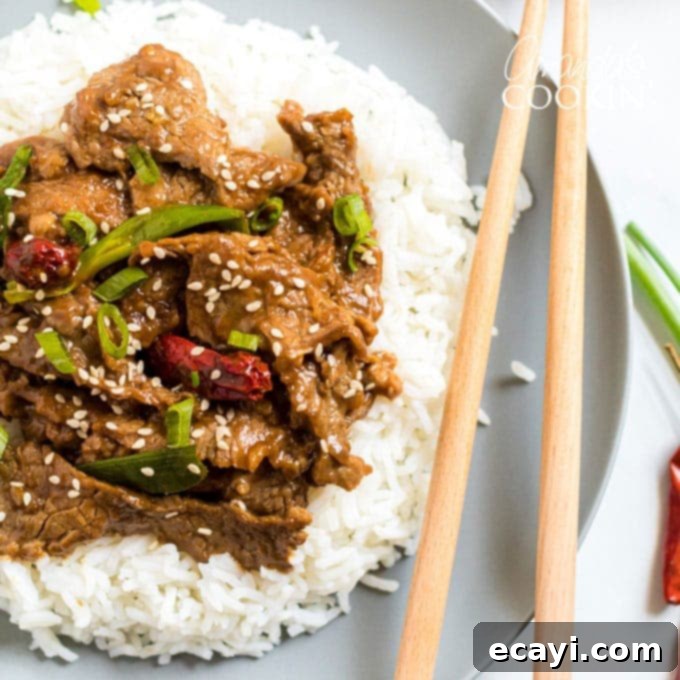The Best Homemade Mongolian Beef Recipe: Sweet, Savory, and Spicy Stir-Fry Perfection
Craving that irresistible sweet, savory, and slightly spicy flavor of restaurant-style Mongolian Beef but want the convenience of cooking at home? Look no further! This homemade Mongolian Beef recipe brings all the authentic tastes and textures right to your kitchen. Featuring tender, thinly sliced flank steak, crisp green onions, vibrant chili peppers, and a rich, deeply flavored sauce, it’s an incredibly easy and delicious weeknight dinner that will quickly become a family favorite. Forget about expensive takeout – with this recipe, you can enjoy a fresh, flavorful, and healthier version of your beloved Chinese-American classic in under 30 minutes!
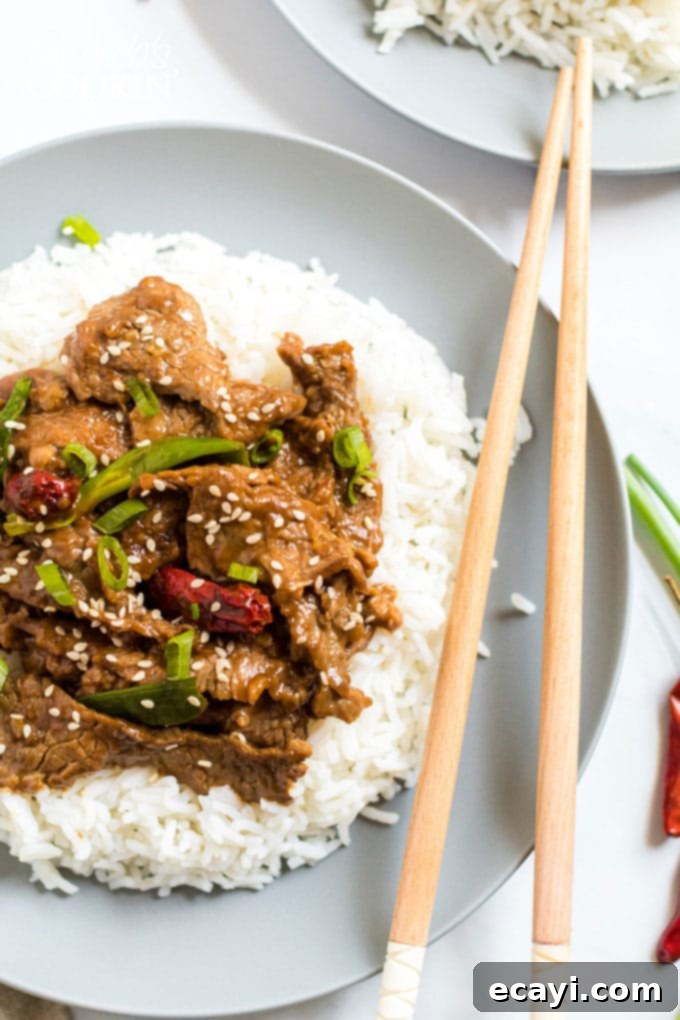
Why This Mongolian Beef Recipe is a Must-Try
There are countless reasons why this Mongolian Beef stir-fry stands out and quickly becomes a staple in busy households. First and foremost, its sheer simplicity and speed make it ideal for those hectic weeknights. From prep to plate, you’re looking at a meal that comes together faster than most delivery services can drop off your order. But speed doesn’t compromise flavor here; every bite is packed with the perfect balance of sweet, salty, and a gentle kick of heat that tantalizes the taste buds, making it far superior to typical store-bought alternatives.
Beyond its convenience, this recipe is a fantastic way to enjoy a meal that’s both satisfying and surprisingly wholesome. Stir-frying, by its nature, is a quick cooking method that helps vegetables retain more of their essential nutrients compared to prolonged cooking methods like boiling or slow roasting. While this particular version focuses on beef and onions, it’s easily adaptable to incorporate more vegetables like bell peppers, broccoli, or snow peas, making it even more nutritious. Plus, knowing exactly what goes into your food gives you peace of mind, especially when you’re looking to control sodium or use high-quality, fresh ingredients.
For those who appreciate the joy of leftovers, this Mongolian Beef is a true winner. If you’re anything like me, you’ll find yourself looking forward to enjoying it again the next day for lunch! I often prepare a double batch just for this reason. It reheats beautifully in the microwave, maintaining its succulent texture and vibrant flavor. And surprisingly, it’s even delicious when enjoyed cold straight from the refrigerator for a quick, satisfying snack. This recipe truly transforms your kitchen into your favorite Chinese restaurant, offering an authentic experience without leaving home, much like my popular Chinese Pepper Steak recipe.
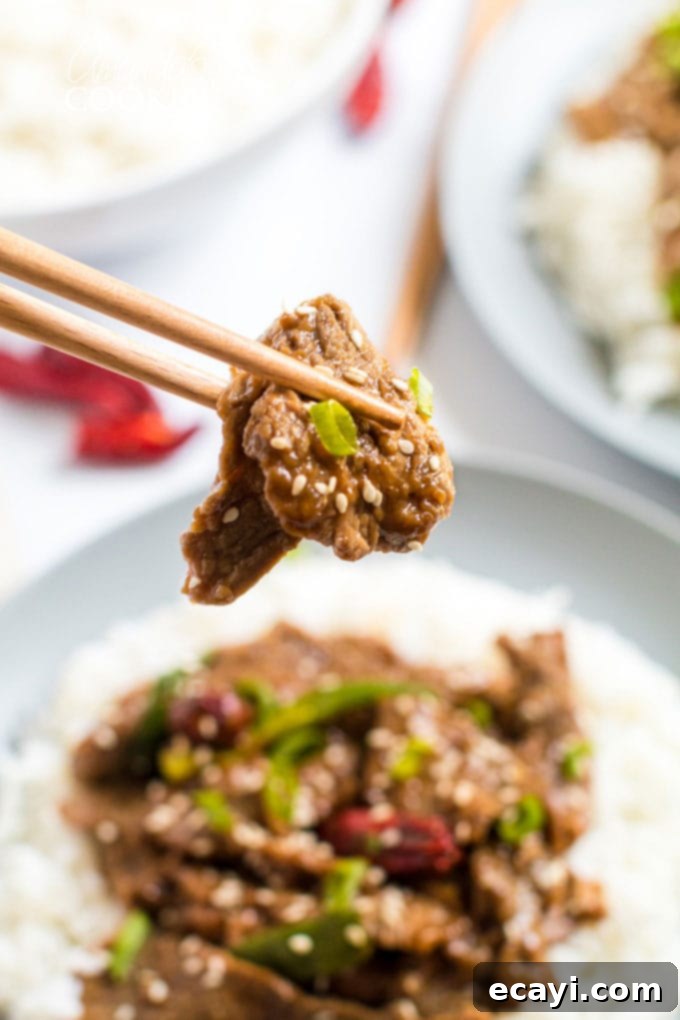
Essential Ingredients for Perfect Mongolian Beef
Crafting exceptional Mongolian Beef starts with selecting the right ingredients. This recipe calls for a balanced combination of fresh produce, quality beef, and pantry staples that come together to create that signature sweet and savory sauce. Each component plays a crucial role in developing the deep, complex flavors characteristic of this beloved Chinese-American dish. While the full list with precise measurements is available in the printable recipe card at the end of this post, here’s a closer look at the key components you’ll need to gather before you begin your stir-fry adventure, ensuring you achieve that perfect homemade takeout taste.
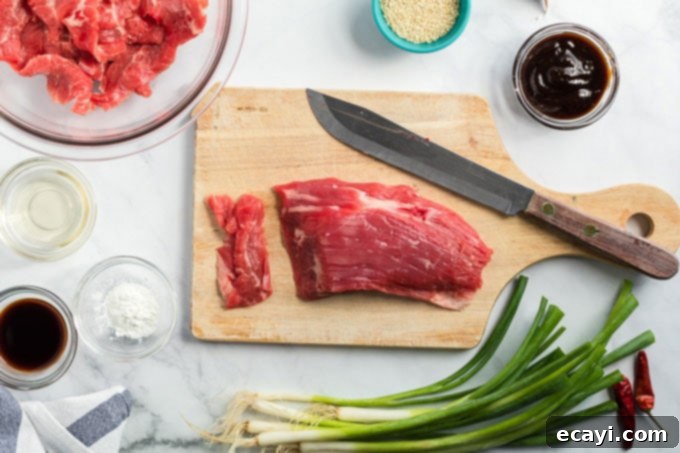
Ingredient Spotlight & Smart Substitutions
Understanding each ingredient’s role and knowing what substitutions are possible can elevate your cooking and ensure success, even if you’re missing a specific item or have dietary preferences. This section will guide you through making informed choices for your homemade Mongolian Beef.
BEEF: Flank steak is undeniably my top recommendation for this Mongolian Beef stir-fry. Its lean nature and robust flavor hold up beautifully to the high heat of stir-frying, absorbing the rich sauce wonderfully. The key to achieving incredibly tender beef is to slice it very thinly and, crucially, against the grain. Slicing against the grain shortens the muscle fibers, making each bite melt-in-your-mouth tender rather than chewy. If flank steak isn’t available, other excellent options include skirt steak, sirloin steak, or even thinly sliced boneless short ribs. Just remember the thin, against-the-grain slicing rule for optimal tenderness, regardless of the cut.
COOKING OIL: I typically reach for canola oil in my stir-fry recipes due to its high smoke point, neutral flavor, and affordability. A high smoke point is vital for stir-frying as it allows you to cook at high temperatures without the oil breaking down and imparting a burnt or unpleasant taste to your food. Peanut oil is another fantastic choice; it also boasts a high smoke point and adds a lovely, subtle nutty flavor that complements Asian dishes wonderfully. Beyond these two, you have several other excellent options with high smoke points suitable for stir-frying, such as avocado oil, corn oil, grapeseed oil, safflower oil, and sunflower oil. While sesame oil has a distinct, appealing flavor, its lower smoke point means it’s best reserved for finishing the dish or added in small quantities to the sauce rather than used for initial stir-frying.
SOY SAUCE: For better control over the overall sodium content of your dish, I highly recommend using low-sodium soy sauce. This allows you to build layers of flavor without making the dish overly salty, giving you the freedom to adjust to your taste. If you’re looking for a gluten-free or lower-carb alternative, Coconut Aminos is an excellent substitute that offers a similar umami depth with a slightly sweeter profile. Tamari is another popular gluten-free option that works well and is widely available.
HOISIN SAUCE: This thick, sweet, and savory sauce is a cornerstone of Mongolian Beef, providing much of its distinctive dark color and rich, complex flavor. It’s usually readily available in the international aisle of most grocery stores. There isn’t a direct perfect substitute that will yield precisely the same flavor, but if you’re in a pinch, you can try combining a little soy sauce, honey or brown sugar, a touch of rice vinegar, a dash of garlic powder, and five-spice powder to mimic its complexity. However, for the most authentic taste and best results, hoisin sauce is highly recommended and worth seeking out.
SHERRY COOKING WINE: Sherry cooking wine adds a subtle depth of flavor and tenderizes the beef during marination, contributing to the overall richness of the dish. While dry sherry is traditional, white cooking wine or even a dry white wine (like Sauvignon Blanc) can be a good substitute. I haven’t personally experimented with red cooking wine for this recipe, but if you have some on hand and prefer a bolder flavor profile, it would likely work, though it might alter the color of the sauce slightly. For an alcohol-free alternative, you can use chicken broth or beef broth, though you might miss a subtle layer of complexity in the final taste.
CORNSTARCH: This is a crucial ingredient for coating the beef, giving it a wonderfully tender texture and a slight crispness that is characteristic of good stir-fries, while also helping the sauce adhere better to the meat. It’s also used to thicken the sauce to that perfect glossy, clingy consistency. There are no direct substitutes that provide quite the same results for coating the beef, but for thickening the sauce, arrowroot powder can be used as a gluten-free alternative, typically using roughly half the amount of cornstarch.
AROMATICS & SPICE: Fresh minced garlic is essential for a pungent, fresh flavor that permeates the dish. While jarred minced garlic can be used in a pinch, avoid dried garlic powder for stir-frying as it won’t provide the same vibrant, fresh taste. Whole dried chili peppers, such as Arbol chili peppers (Chile de árbol), provide that characteristic subtle heat and visual appeal. You can adjust the quantity based on your preferred spice level, or omit them entirely for a milder dish. For those who can’t handle the heat, sweet peppers or bell peppers (sliced thinly) can be used for color and crunch without the spice. Finally, green onions are not just a garnish; they add a fresh, pungent, and slightly sweet oniony flavor that brightens the entire dish and provides a lovely textural contrast.
Step-by-Step Guide to Crafting Delicious Mongolian Beef
These step-by-step photos and detailed instructions are designed to help you visualize and effortlessly create this incredible Mongolian Beef recipe. Remember, to get the full printable version of this recipe, complete with precise measurements and comprehensive instructions, simply Jump to Recipe at the bottom of this post.
A successful stir-fry relies heavily on efficient preparation, a culinary concept known as “mise en place.” Before you even turn on the stove, ensure all your ingredients are sliced, chopped, measured, and ready to go. Stir-frying is a very quick process, and you won’t have time to chop or measure mid-cook without risking overcooking your ingredients!
- Begin by preparing your beef for optimal tenderness and flavor absorption. Place the thinly sliced flank steak in a medium bowl. Add the sherry cooking wine and cornstarch to the beef. Mix these ingredients thoroughly with your hands until every piece of beef is lightly and evenly coated. This marinating step is key for tenderizing the meat and ensuring the rich sauce adheres beautifully later on. Allow the beef to marinate for a minimum of 15 minutes at room temperature, which is just enough time to prepare your sauce and other vegetables.

- While the beef marinates, prepare your signature Mongolian Beef sauce. In a separate small dish, combine 2 tablespoons of the hoisin sauce with all of the soy sauce. Whisk these together until they are well combined and smooth, then set this flavorful mixture aside. This will be added towards the end to bring all the savory and sweet flavors together.
- Once the 15 minutes of marination for the beef are complete, add the remaining 1 teaspoon of hoisin sauce directly to the beef mixture in its bowl. Mix it in well with the beef, ensuring an even distribution. This extra touch of hoisin before cooking adds another layer of depth and savory sweetness directly to the meat, enhancing its flavor profile even further.
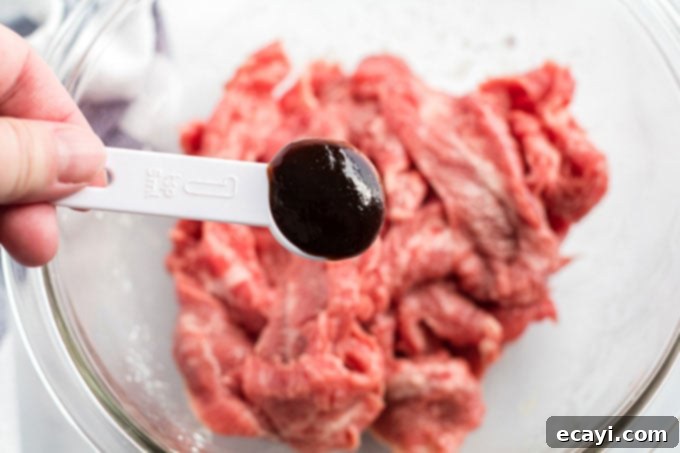
- Now it’s time to cook the beef. Heat 1 tablespoon of the cooking oil in a wok or a large, heavy-bottomed skillet over high heat until it just begins to shimmer and smoke slightly. This high heat is crucial for a proper sear. Add the marinated beef to the hot pan, spreading it in a single layer if possible. If your pan isn’t large enough, cook the beef in two batches to avoid overcrowding, which can cause the meat to steam instead of sear. Stir-fry for only 2-3 minutes, or until the beef is mostly browned and no longer pink. It’s crucial not to overcook the beef, as this will make it tough and chewy. A little pinkness remaining is perfectly fine, as it will continue to cook slightly when combined with the hot sauce later.
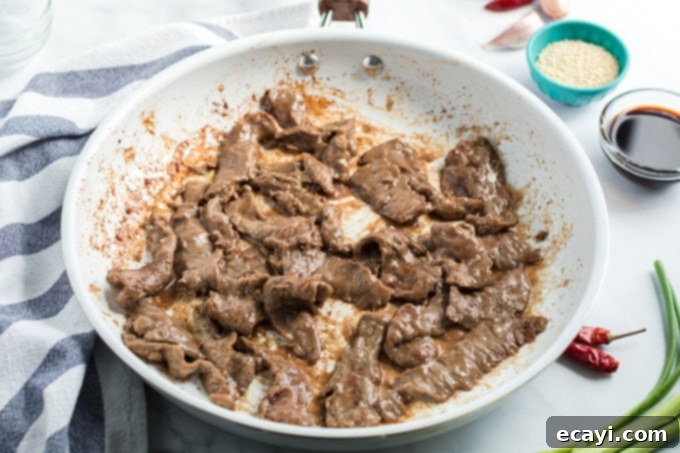
- Carefully remove the cooked beef from the wok and transfer it to a clean bowl, setting it aside. Return the now empty wok to the stove over high heat. Add the remaining 1/2 tablespoon of oil to the hot wok. Immediately add the minced garlic, whole dried chili peppers (if using), and the cut green onions. Stir-fry these aromatics and vegetables for 2-3 minutes, just until they are wonderfully fragrant and the green onions have softened slightly but still retain a bit of their crispness. Be careful not to burn the garlic, as burnt garlic can taste bitter.

- To combine everything and finish your magnificent dish, push the stir-fried vegetables to one side of the wok, creating an open space in the center. Return the cooked beef to the other side of the wok. Pour the prepared soy sauce and hoisin mixture directly into the center of the wok, allowing it to heat and bubble for a few seconds. Then, quickly stir to combine the beef, vegetables, and the rich, glossy sauce thoroughly. Continue to stir-fry for just about a minute, or until the sauce has thickened and beautifully coated all the ingredients. Serve your piping hot, homemade Mongolian Beef immediately over freshly cooked white rice, brown rice, or thin rice noodles for a complete and satisfying meal that rivals any takeout!
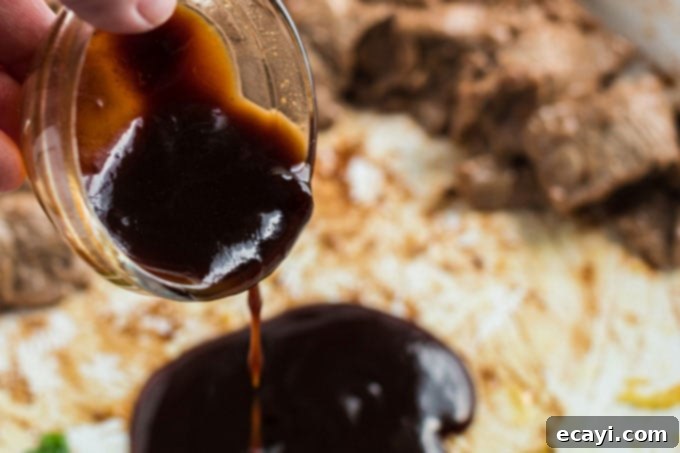
Frequently Asked Questions & Expert Tips for Mongolian Beef Success
Any leftover Mongolian Beef should be stored promptly in an airtight container in the refrigerator for up to 3-4 days. For the best quality and food safety, ensure it cools down before refrigerating. When reheating, whether in the microwave or on the stovetop, you might find the sauce has thickened considerably. To loosen it up and restore its luscious consistency, add a small amount (1-2 tablespoons) of water or beef broth before reheating. This will prevent the dish from drying out and ensure it’s as delicious as it was fresh, making leftovers a joy.
Absolutely! While the classic Mongolian Beef often features just beef and green onions, adding other vegetables is a fantastic way to boost nutrition, add vibrant color, and introduce more textural variety. Great additions include thinly sliced carrots, colorful bell peppers (red, yellow, or orange for visual appeal), crisp snow peas, tender broccoli florets, or even water chestnuts and bamboo shoots for added crunch and an authentic Asian flair. Remember to add harder vegetables like carrots or broccoli first, allowing them to cook for a few minutes before adding softer ones like bell peppers or snow peas, ensuring everything cooks evenly.
Achieving super thin, uniform slices is paramount for tender stir-fry beef. A top trick is to partially freeze the flank steak for about 30-45 minutes before slicing. This firms up the meat without making it rock-hard, making it significantly easier to cut into thin, even pieces. Always use a very sharp knife and, crucially, slice against the grain. Look closely for the parallel lines (the muscle fibers or “grain”) of the meat and cut perpendicular to them. This technique shortens the muscle fibers, resulting in incredibly tender beef.
If your Mongolian Beef sauce isn’t thickening to that perfect glossy consistency, it might be due to insufficient cornstarch in the recipe, or simply not enough time to simmer and activate the cornstarch. Ensure you’re cooking at a high enough heat to properly thicken the sauce. If it’s still too thin after a minute or two of simmering with all ingredients, you can easily make a quick cornstarch slurry: mix 1 teaspoon of cornstarch with 1 tablespoon of cold water until smooth. Pour this slowly into the simmering sauce while stirring continuously until it reaches your desired thickness. Remember, the sauce will also thicken slightly more as it cools.
Yes, many elements of this Mongolian Beef recipe can be prepped in advance to make dinner even faster. You can slice the flank steak and marinate it in the sherry and cornstarch mixture for up to 24 hours in the refrigerator. The sauce ingredients (hoisin and soy sauce) can be mixed together and stored in an airtight container in the fridge for a couple of days. All your vegetables, including minced garlic, chili peppers, and green onions, can be chopped and ready to go a day in advance. This “prep-ahead” strategy is a stir-fry game-changer!
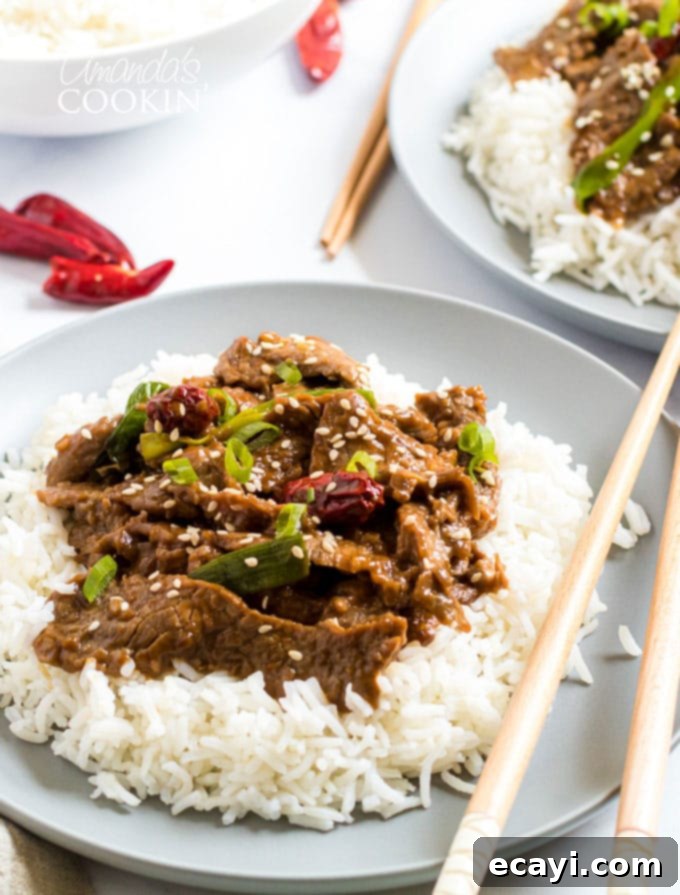
Delightful Serving Suggestions for Your Mongolian Beef
This savory and sweet Mongolian Beef stir-fry is a complete meal in itself, brimming with flavor and satisfying textures. However, the way you choose to serve it can truly enhance the dining experience, transforming a simple weeknight dinner into a culinary event. As written, this recipe comfortably serves 3-4 people, making it perfect for a cozy family dinner or a small gathering. If you’re hosting more guests or, like me, you love having delicious leftovers for the week, it’s incredibly easy to double or even triple the recipe. Just ensure you don’t overcrowd your wok or skillet when cooking the beef and vegetables, as this can lead to steaming rather than stir-frying, affecting the final texture.
The most classic and popular accompaniment for Mongolian Beef is, of course, a generous bed of fluffy white rice. Its neutral flavor and soft texture perfectly complement the rich, bold sauce and tender beef, acting as a perfect canvas to soak up all the delicious juices. For a healthier or more fibrous option, brown rice works equally well and adds a nutty undertone. If you prefer noodles, thin rice noodles or even lo mein noodles can be an excellent choice to serve as a base, allowing them to absorb all that incredible sauce. Prepare them separately according to package directions and then spoon the Mongolian Beef directly over them.
If you’ve fallen in love with this amazing sauce and its versatility, don’t limit yourself! Use it as a fantastic base to create your very own custom stir-fry recipes. Experiment with a variety of different vegetables to add texture, color, and nutrients. Consider adding thinly sliced celery for a crisp bite, colorful sweet bell peppers (red, yellow, or orange) for a mild sweetness and visual appeal, or crunchy water chestnuts and bamboo shoots for an authentic Asian flair. A sprinkle of toasted sesame seeds over the finished dish not only adds a lovely visual appeal but also provides a delightful nutty aroma and crunch, elevating the presentation. For a refreshing contrast, serve alongside a simple cucumber salad dressed with a light vinaigrette or a light, Asian-inspired coleslaw.
Explore More Irresistible Stir-Fry Recipes
If you enjoyed the quick and flavorful nature of this homemade Mongolian Beef, you’re in for a treat! Stir-fries are a cornerstone of Asian cuisine for good reason – they’re fast, versatile, and incredibly delicious, making them ideal for busy weeknights. Expand your culinary repertoire with some of my other top-rated stir-fry and Asian-inspired dishes that are just as easy to make and guaranteed to satisfy your cravings. Each one offers a unique flavor profile and a wonderful homemade experience, transforming simple ingredients into memorable meals that your family will adore.
- Sesame Chicken
- Moo Goo Gai Pan
- Chinese Pepper Steak
- Teriyaki Chicken and Rice
- Szechuan Beef
- Beef Lo Mein
- General Tso Chicken
I love to bake and cook and share my kitchen experience with all of you! Remembering to come back each day can be tough, that’s why I offer a convenient newsletter every time a new recipe posts. Simply subscribe and start receiving your free daily recipes!

Mongolian Beef
IMPORTANT – There are often Frequently Asked Questions within the blog post that you may find helpful. Simply scroll back up to read them!
Print It
Rate It
Save ItSaved!
Ingredients
- ½ pound flank steak sliced thin against the grain*
- 1 ½ tablespoons canola oil divided
- 1 tablespoon sherry cooking wine
- 1 teaspoon cornstarch
- 2 tablespoons hoisin sauce plus 1 teaspoon
- 1 tablespoon soy sauce
- 2 cloves garlic minced
- 4 whole dried chili peppers
- 6 green onions cut into 2″ pieces
- 2 teaspoons sesame seeds optional
Things You’ll Need
-
Large skillet
Before You Begin
- While I highly recommend fresh cloves of garlic for the best, most vibrant flavor, you can use jarred minced garlic if convenience is a priority. Please do not use dried garlic powder or flakes in place of fresh minced garlic for this recipe, as the flavor profile will be significantly different and lack the desired pungency.
- Navigating the world of dried chili peppers can sometimes be a bit confusing. For this recipe, I typically opt for whole Arbol chili peppers (Chile de árbol). They provide a moderate, pleasant heat and are commonly found in most grocery stores’ international or spice aisles. Feel free to adjust the quantity based on your personal preference for spice, or even deseed them for less heat.
- To add an extra layer of visual appeal and a delightful nutty crunch, consider garnishing the finished dish with a sprinkle of toasted sesame seeds just before serving. This simple addition elevates both the look and texture of your homemade Mongolian Beef.
- A fundamental rule for any successful stir-fry is thorough preparation beforehand. Stir-fry dishes are known for their incredibly fast cooking times, which means you won’t have the luxury of stopping to chop or measure ingredients mid-cooking. To ensure a smooth and stress-free process, make sure to slice, cut, chop, and precisely measure all ingredients before you even begin heating your wok or skillet. It’s also a smart idea to get your accompanying rice or noodles cooking first, as their preparation time might exceed the actual stir-frying time for the beef.
- If you or your family members are sensitive to heat or simply don’t prefer spicy foods, you can easily adapt this recipe. Instead of the whole dried chili peppers, you can use thinly sliced sweet peppers or colorful bell peppers (such as red, yellow, or orange). They will still add a beautiful vibrant color and a pleasant crunch without introducing any heat, making the dish palatable for everyone.
- For even more tender beef, consider a technique called velveting. After slicing the beef, marinate it with a mixture of cornstarch, a little soy sauce, and a dash of oil for at least 30 minutes (this recipe already incorporates some of these elements). This creates a protective coating that locks in moisture during cooking, resulting in exceptionally tender meat.
- Ensure your wok or skillet is screaming hot before adding the oil and beef. This high heat is essential for achieving a proper sear and preventing the beef from steaming, which can lead to a less desirable, tougher texture. Cook in batches if necessary to maintain high heat and achieve that perfect browning.
Instructions
-
Place beef in a bowl and add sherry cooking wine and cornstarch. Mix together and marinate for 15 minutes. This step tenderizes the beef and helps the sauce adhere beautifully.
-
Meanwhile, in a separate small dish mix together 2 tablespoons of the hoisin sauce and all of the soy sauce and set aside. This creates the foundational flavorful sauce base.
-
When beef is ready, add remaining 1 teaspoon of hoisin sauce and mix into beef. This adds an extra layer of hoisin flavor directly to the meat before cooking.
-
Heat a tablespoon of the cooking oil in a wok or skillet over high heat until it just begins to smoke. Add beef and stir fry for 2-3 minutes, or until no longer pink. Don’t cook too long or it will get tough! If it’s still a little pink, it’s okay as it will finish cooking with the sauce. Cook in batches if your pan is not large enough to avoid overcrowding and ensure proper searing.
-
Remove the cooked beef to a bowl and return wok to the stove. Add the remaining 1/2 tablespoon of oil to the wok and stir fry the minced garlic, chili peppers, and green onion for 2-3 minutes, until fragrant and slightly softened.
-
Move the vegetables to one side of the wok, add beef to the other side. Pour the soy sauce mixture into the center and stir a little then combine beef, vegetables and sauce. Stir just a minute or so, allowing the sauce to thicken and coat all ingredients beautifully. Serve immediately over rice or thin noodles for the ultimate homemade Mongolian Beef experience.
Nutrition
The recipes on this blog are tested with a conventional gas oven and gas stovetop. It’s important to note that some ovens, especially as they age, can cook and bake inconsistently. Using an inexpensive oven thermometer can assure you that your oven is truly heating to the proper temperature. If you use a toaster oven or countertop oven, please keep in mind that they may not distribute heat the same as a conventional full sized oven and you may need to adjust your cooking/baking times. In the case of recipes made with a pressure cooker, air fryer, slow cooker, or other appliance, a link to the appliances we use is listed within each respective recipe. For baking recipes where measurements are given by weight, please note that results may not be the same if cups are used instead, and we can’t guarantee success with that method.
This recipe was originally published here on March 13, 2009, and has been updated with enhanced details and expert tips for an even better cooking experience.
